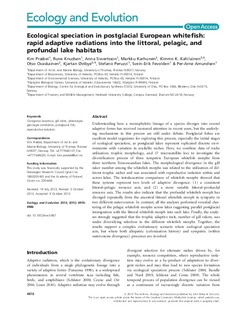| dc.contributor.author | Præbel, Kim | |
| dc.contributor.author | Knudsen, Rune | |
| dc.contributor.author | Siwertsson, Anna | |
| dc.contributor.author | Karhunen, Markku | |
| dc.contributor.author | Kahilainen, Kimmo K. | |
| dc.contributor.author | Ovaskainen, Otso | |
| dc.contributor.author | Østbye, Kjartan | |
| dc.contributor.author | Peruzzi, Stefano | |
| dc.contributor.author | Fevolden, Svein-Erik | |
| dc.contributor.author | Amundsen, Per-Arne | |
| dc.date.accessioned | 2013-12-16T09:42:20Z | |
| dc.date.available | 2013-12-16T09:42:20Z | |
| dc.date.issued | 2013 | |
| dc.identifier.citation | Præbel, K., Knudsen, R., Siwertsson, A., Karhunen, M., Kahilainen, K. K., Ovaskainen, O., . . . Amundsen, P.-A. (2013). Ecological speciation in postglacial European whitefish: rapid adaptive radiations into the littoral, pelagic, and profundal lake habitats. Ecology and Evolution, 3(15), 4970-4986. doi: 10.1002/ece3.867 | no_NO |
| dc.identifier.uri | http://hdl.handle.net/11250/134632 | |
| dc.description | This article is also available at onlinelibrary.wiley.com | no_NO |
| dc.description.abstract | Understanding how a monophyletic lineage of a species diverges into several
adaptive forms has received increased attention in recent years, but the underly-
ing mechanisms in this process are still under debate. Postglacial fishes are
excellent model organisms for exploring this process, especially the initial stages
of ecological speciation, as postglacial lakes represent replicated discrete envi-
ronments with variation in available niches. Here, we combine data of niche
utilization, trophic morphology, and 17 microsatellite loci to investigate the
diversification process of three sympatric European whitefish morphs from
three northern Fennoscandian lakes. The morphological divergence in the gill
raker number among the whitefish morphs was related to the utilization of dif-
ferent trophic niches and was associated with reproductive isolation within and
across lakes. The intralacustrine comparison of whitefish morphs showed that
these systems represent two levels of adaptive divergence: (1) a consistent
littoral
–
pelagic resource axis; and (2) a more variable littoral
–
profundal
resource axis. The results also indicate that the profundal whitefish morph has
diverged repeatedly from the ancestral littoral whitefish morph in sympatry in
two different watercourses. In contrast, all the analyses performed revealed clus-
tering of the pelagic whitefish morphs across lakes suggesting parallel postglacial
immigration with the littoral whitefish morph into each lake. Finally, the analy-
ses strongly suggested that the trophic adaptive trait, number of gill rakers, was
under diversifying selection in the different whitefish morphs. Together, the
results support a complex evolutionary scenario where ecological speciation
acts, but where both allopatric (colonization history) and sympatric (within
watercourse divergence) processes are involved. | no_NO |
| dc.language.iso | eng | no_NO |
| dc.publisher | Wiley | no_NO |
| dc.subject | Coregonus lavaretus | no_NO |
| dc.subject | gill raker | no_NO |
| dc.subject | phenotype – genotype correlation | no_NO |
| dc.subject | postglacial fish | no_NO |
| dc.subject | reproductive isolation | no_NO |
| dc.title | Ecological speciation in postglacial European whitefish: rapid adaptive radiations into the littoral, pelagic, and profundal lake habitats | no_NO |
| dc.type | Journal article | no_NO |
| dc.type | Peer reviewed | no_NO |
| dc.subject.nsi | VDP::Agriculture and fishery disciplines: 900::Fisheries science: 920 | no_NO |
| dc.source.volume | 3 | no_NO |
| dc.source.journal | Ecology and evolution | no_NO |
| dc.source.issue | 15 | no_NO |
| dc.identifier.doi | 10.1002/ece3.867 | |
